[Updated March 23, 2018]
Every owner should have a first-aid kit for their dogs. But what should be included in that kit? If you’re looking for a definitive answer, you’ll need to pull out your crystal ball, because there’s no telling what you might need in an emergency, since there are infinite ways your dog can be injured. To be prepared for every possible scenario, you’d need a fully stocked van. It really can’t be done – and shouldn’t be done – because that’s not what “first aid” is all about.
First aid is the care given to an injured dog until full veterinary services are available. It is not a replacement for veterinary care. Your goal is to temporarily make your dog’s situation better – stop the bleeding, apply a splint, perform CPR – whatever you need to do to sustain life, reduce further injury, and decrease pain until a veterinarian can take over.
When shopping, it’s important to understand the difference between first-aid kits and disaster kits. A disaster kit is stocked to maintain life for days during a crisis, such as a hurricane. It contains food, water, safe-haven information, crates, ropes, extra collar and leash, daily medications, emergency phone numbers, photo IDs for each animal, basic first-aid supplies, and so on.
In contrast, a first-aid kit should contain supplies that are sufficient to handle most injuries that might occur in your dog’s normal, daily life.
That said, there is a wide variety of canine first-aid kits available, ranging from being rather minimally equipped, to fairly well-stocked with useful items. However, when we shopped for kits, in order to assess and review them for this article, we didn’t find any that contained everything our veterinary advisors thought a first-rate first-aid kit for dogs should contain! There were a couple that came close, though – and we will reveal our top picks, and what we’d add to make these choices more complete.
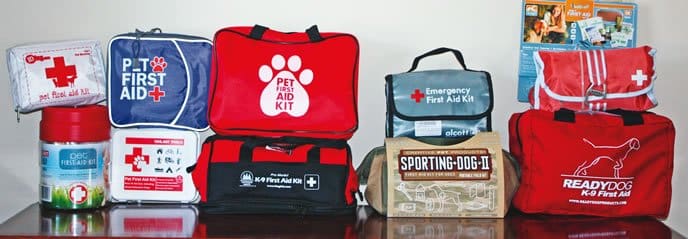
Your Dog’s First Aid Needs May Vary
When we started shopping, we were looking for the kit that contained the most useful items possible. It didn’t take long, however, to realize that the “best” kit for a working sheepdog on a huge ranch or a search-and-rescue dog who is routinely trained or deployed in the mountains may be overkill for a dog who lives in an urban setting and is walked only on-leash.
Further, all the medical supplies in the world are useless if they are in the hands of someone who faints at the sight of blood; your own abilities to handle a medical emergency, minor or major, may also affect which kit would be appropriate for you to own.
Points to Consider When Shopping for Pet First Aid Kits:
Your choice of a canine first-aid kit, then, may be influenced by your and your dog’s unique needs, including:
1. Your ability to administer first aid. If you feel woozy when you find a blood-bloated tick on your dog, all the gauze and 4x4s in the world will not help you when your dog comes to you yelping and with a gaping wound. However, pretty much anyone can deal with cold packs for sprains or use a syringe to flush out an injured eye with sterile eyewash.
Sometimes first-aid or emergency situations involve more technique than products. Learning in advance how to administer CPR to your dog and how to retrieve a foreign object that obstructs breathing can be a life-saver. YouTube carries some excellent videos on techniques, but we suggest you choose those uploaded by a veterinarian, veterinary hospital, or clinic.
Even for minor injuries, like a torn nail or bee sting, it’s wise to familiarize yourself with basic first aid prior to when you need it. We frequently thumb through the Dog Owner’s Home Veterinary Handbook, Fourth Edition (by Drs. Eldredge, Carlson, Carlson, and Giffin), because it’s thorough and contains user-friendly advice.
2. How many dogs you own, their activity level, and travel/time away from home. A quiet stay-at-home pet has a lower risk of injury than the sporting dog who runs, jumps, twists, and turns. Dogs who are active in wilderness areas – ones who hunt or hike with you – have a greater risk of injury, not just from the terrain but also from wildlife, poisonous plants, and insects they may encounter. The more adventures you share with your dog, the higher the risk of an accident.
3. Your needs for kit portability and storage. Your first-aid kit should be in an easily accessible location. Hunting down supplies in an emergency wastes critical minutes. We don’t recommend permanent storage in your car or garage, as the temperature extremes can be harmful to some of the contents, but it’s a better option than forgetting to take the kit with you.
Some first-aid kits are made to fold up or roll up, making it easy to locate the supply you need while taking up little space. They’re a great choice for tossing in your backpack to bring along on trips with your dog.
The Contents of Your Dog’s First Aid Kit
As mentioned above, we asked some veterinarians what they would include in an ideal first-aid kit; their wish list appears in the table below. However, none of the commercial kits we found on the market contained everything recommended by our experts. You could build your own first-aid kit from scratch by going down our chart list. However, it’s most efficient – in terms of time and money – to begin with the commercial kit that most closely fits your individual needs and simply add supplies to it. Our descriptions of the 10 most promising canine first-aid kits on the market can help guide you toward the base product that would work best for you and your dogs.
Useful Items for a Dog’s First Aid Kit:
| ITEM | APPLICATION |
| Abdominal pad | Large absorbent pad, usually gauze, for large wounds and heavy bleeding. Best if sterile. |
| Adhesive bandage tape | Inch-wide tape is more comfortable and secure than narrower tape. Use to secure bandages and gauze. |
| Alcohol | Either in a bottle or used to soak gauze pads soaked in sealed packets. Use to sterilize scissors, tweezers, etc. |
| Antibiotic ointment | Prevents infection. |
| Antiseptic | 10% povidone iodine often included in kits; Nolvasan is a good alternative. Pre-wetted pads seem convenient, but we prefer at least a 4-oz. bottle of antiseptic. Use to clean wounds, your hands, equipment, etc. Using a syringe to apply it will waste less of it. |
| Benedryl (Diphenhydramine) | Use these tablets for allergic reactions or severe itching caused by insect bites or bee stings. |
| Cotton shirt or towel | A white cotton t-shirt or towel can be used for packing or wrapping large wounds. |
| Cotton swabs | Use to apply ointments and solutions. |
| Old credit card | An expired credit card is perfect for scraping off bee stingers. |
| Elizabethan collar (or alternative) | Probably too big to keep in your kit, but having one in advance of an injury can prevent a dog from worsening a wound. |
| Emergency blanket | Use to provide warmth due to weather, shock, or exposure. Most are packed in tiny packets and are silver, which can also double as a flag to get someone’s attention. |
| Exam gloves | Use to avoid further contaminating open wounds. Choose latex-free gloves if you or your dog is sensitive to latex. |
| First-aid instructions | A written how-to can be useful, but it must be written for use in an emergency – clear and concise. |
| Gauze pads | Use to absorbing blood or bandage wounds. Pads smaller than 3 inches square are unhelpful, except on the smallest dogs. |
| Gauze rolls | Can be used to hold cold packs in place, bandage wounds, stabilize splints, or for a temporary muzzle. |
| Hemostat, forceps, or needle-nose pliers | A smaller, thinner hemostat can be used to remove objects from dog’s throat or to hold skin or bandage pieces in place. Needle-nose pliers can also be used to gently remove porcupine quills or debris from large wounds. |
| Honey | Administer for shock; Karo syrup is also a good choice. |
| Hydrogen peroxide | Use as a wound wash or to induce vomiting when needed. Dosage is usually 1 teaspoon per 10 lbs of body weight. Also works to remove skunk odor. |
| Instant cold press | Use for stings, bruises, inflammation. (At home, you can use frozen vegetable bags or ice bags instead of the instant type.) |
| Muzzle | Use for any dog in severe pain to prevent being bitten while you are carrying him or otherwise trying to help him. |
| Penlight | Use to help you see more clearly into the dog’s ear, mouth, or wound. (And pack spare batteries.) |
| Phone numbers | Include numbers for veterinary poison control (888-426-4435); your veterinarian; and your local veterinary emergency clinic. |
| Rehydrate tablets | Electrolyte tablets can be critical for a severely dehydrated dog or one with heatstroke. |
| Scissors | Use to trim hair away from wounds, or for gauze and bandages. Blunt-tipped scissors are ideal. |
| Cohesive bandages | (Vetrap or CoFlex.) This 3-inch-wide, stretchy bandage, made of a material that sticks to itself, is ideal for fast bandaging. |
| Skin Stapler | Use to hold edges of a gaping wound together, to help control bleeding and worsening of wound. |
| Sterile eye wash | Use to flush debris or caustic material (including skunk spray!) from eyes. |
| Sterile wound wash | Use in a syringe to irrigate and flush debris from wounds. |
| Styptic powder | Use to help stop bleeding (toenails, minor wounds). |
| Syringes | For flushing a dog’s wounds or eyes. |
| Thermometer | Taking a dog’s temperature is especially critical in case of heat stroke or hypothermia. |
| Tick remover | A good tick remover works far better and faster than tweezers. |
| Tongue depressor | A tongue depressor is invaluable for examining a dog’s mouth or throat; it can also be used as a splint on a smaller dog. |
| Tweezers | Removing debris from wounds, splinters, etc. |
A few notes about the contents recommended by our experts:
Benadryl tablets
Discuss dosages of this useful antihistamine with your veterinarian. A common recommendation for dogs is 1 mg per pound of the dog’s body weight every eight hours, up to a maximum of 50 mg (regardless of the dog’s weight). A Benadryl tablet contains 25 mg of the antihistamine, so a small dog, weighing around 8 pounds, would receive about one-third of a tablet.
Expiration dates
Anything perishable in the kits – including antibiotic ointment, peroxide, anti-histamines, or sterilizing agents – should bear an expiration date that is well into the future.
Gauze
If you’re ever faced with a serious bleeding situation, you’re going to want a great deal of gauze. Most of the kits could use a little plumping up in this department.
Muzzle
Even the kindest dog on earth may bite when in pain. If you already own a soft muzzle, keeping it in the kit would be an excellent idea. In an emergency, one can also fashion a muzzle out of a roll of gauze, provided you have enough in the kit and you take the time to learn to do it before you need it.
Skin Stapler
While you may feel you’ll never need a skin stapler, our veterinarian rattled off several scenarios where one could be crucial, for helping keep a large wound from opening further on the way to a veterinary clinic.
Syringes
Not one of the kits we reviewed included more than one syringe, indicating once again that these kits seem to be conceived as single-use items. We’d definitely stock more syringes in our kits; they are highly useful for flushing wounds or eyes.
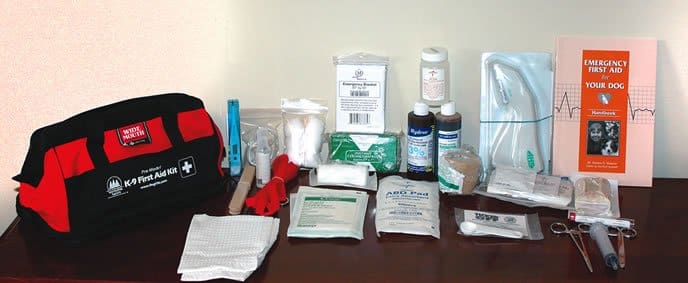
Whole Dog Journal First Aid Kit Reviews
We have to admit, we were surprised by the appearance of some of the tiniest cotton balls we’ve ever seen, and miniscule packets of ointments and antiseptics. But as Eileen Fatcheric, DVM, of Syracuse, New York, explains, “Keep in mind the purpose of a first-aid kit: It’s basically designed for one incident. After that, you replenish the supplies you used.” Still, in almost every case, we wish the kits included a more generous number of gauze pads and bandages.
Now that we’ve explained what we are looking for in a useful first-aid kit, let’s take a look at the 10 kits we examined, in order of their purchase prices.
IDTag.com Pet First Aid Kit – $7
We had to look at the first-aid kit sold by IDTag.com; it was the least expensive one we could find. Surprisingly, it has one of the better quick-reference first-aid instruction sheets we saw, and it crams a lot of stuff into a tiny pack. It contained 47 pieces, including 15 of our recommended items.
However, the small zipper case had an “oily” smell, and several of the products inside had a 2009 expiration date! The word “sterilze” (sic) printed on the abdominal pad didn’t help our confidence level. It may be a very basic kit at a rock-bottom price, but we wouldn’t buy it again.
We purchased from amazon.com. It can also be puchased from dealgenius.com; (773) 276-1001.
Alcott Emergency First Aid Kit – $21
The “Pets and People Travel Size” first-aid kit from Alcott is well stocked, containing 40 pieces, including 19 of our recommended items. One very important item that should be added: scissors.
We like the compact fold-out/roll-up design and its carrying handle. However, we’d swap out some of its contents for more useful supplies. A small bottle of hydrogen peroxide is a great addition but its packaging in a clear bottle can negate its effectiveness. Plus, the bottle was labeled as “3% w/v Hydrogen Peroside” (sic), which made us uneasy. Reminding us the kit is for pets and people, the kit includes a CPR barrier shield. At $21, this isn’t a bad start, but we’d dump the dog brush and human hand sanitizer and add a thermometer, scissors, and forceps.
Made by Alcott. We found it at alcottadventures.com; (513) 874-5383.
Lixit Pet First Aid Kit – $21
This kit is packaged in a plastic canister with a handle and a top that can double as a water bowl. It’s nicely stocked for basic first aid needs (containing 45 pieces, including 18 of our recommended items), and includes a good instruction sheet.
We wish it included some paper bandage tape, even though the 1-inch-wide self-adhesive bandage tape can serve double duty. It includes a syringe but no sterile wound wash or antiseptic for flushing wounds. Fortunately, there’s ample room in the canister for the addition of these basic supplies.
First Aid USA Pet First Aid Kit – $28
The Pet First Aid Kit from First Aid USA is contained within an impressive fold-out nylon pouch with a zip closure. We like its see-through pockets and mesh. This kit’s designers were smart enough to include a leash, water bowl, and a tweezers/tick remover with a magnifying glass among the 50 pieces included in the kit (including 16 of our recommended items).
Things we didn’t like: the absence of first-aid instructions, and the inclusion of an empty bottle – presumably for wound wash, but you’ll break the sterility of your solution by pouring it into that bottle. The empty bottle takes up a lot of space, but the pill container is useful. By swapping a few of the nonsensical items for some more useful ones, you’d have a contender.
We purchased from amazon.com; sorry, no phone purchasing.
Vigilant Trails Pet First Aid Kit – $30
This kit was contained in a plastic container that can double as a water dish. It’s compact and stuffed full, with 70 pieces, including 15 of our recommended items. The first-aid tip sheet is excellent. There were no instructions on how to use the venom extraction pump – and though we did figure it out, the current recommendation from veterinary experts who deal with snake bites is to rush your dog to a vet, rather than waste time trying to get venom out of a bite wound (see “Don’t Get Rattled,” page 5).
The kit includes antihistamine tablets (generic version of Benadryl) but offers no guidance on dosage. The emergency whistle feels dated in today’s cell-phone age, but you never know. Overall, we like this kit, but we’d switch out the adhesive bandages for more gauze pads and rolls.
We purchased the kit from vigilant-trails.com; (408) 471-8767.
Kurgo Pet First Aid Kit – $30
A really good booklet, with clear instructions for many emergencies, is included with this kit made by Kurgo. The nylon roll-up carrier has three zip pockets and one mesh pocket, and contains 50 pieces, including 14 of our recommended items. We like that the outer tie is adjustable, so it could accommodate more supplies.
You can get a complete refill kit from Kurgo for $15, half the original price. Buying the refill kit and providing your own case would provide you with the best-priced starter kit around.
This kit can be purchased directly from kurgo.com; (877) 847-3868.
Essential Pet First Aid Kit – $35
This kit, made by JoJo Modern Pets, is packaged in a nylon pouch that opens up flat; the supplies (30 pieces, including 14 of our recommended items) are contained in the two inside compartments. The instruction card tells you what the contents are for, which is helpful. The kit included the fewest items of all the kits we looked at; it definitely seems to be designed for a single emergency use.
We like the saline wound wash and wide bandage tape in the kit, but overall, we think there are better values. This kit can be purchased directly from its maker, jojomodernpets.com; (855) 226-5656.
Sporting Dog II First Aid Kit – $46
The Sporting Dog II Portable Field First Aid Kit is packed in a wide-mouth top-zip canvas tote with four padded outer pockets. The tote contains 36 pieces, including 16 of our recommended items. A good first-aid book, written by a veterinarian, is included.
We like that the kit contains generously sized bottles of sterile saline, hydrogen peroxide (properly packaged in dark container), and 10% povidone iodine. We realize that once you open them, their shelf life is shortened, but it simply builds confidence to know you have plenty to work with. The full-size surgical hand scrub sponge is far more inviting than using several tiny antiseptic towelettes. The kit also includes two paper towels, plus cohesive (sticks to itself) bandage, and a pill popper. The company also offers a larger kit with more supplies.
The kit is made by Creative Pet Products. We purchased it from First-Aid-Product.com; (888) 228-6694.
Pro Model 1000 First Aid Kit – $70
Outdoor Safety’s Pro Model 1000 First Aid Kit is packaged in a stiff canvas bag that is hinged to stay open, with web handles, a wide top zipper, and pockets on each side (one with snap closure). A bottom zipped compartment holds a comprehensive first-aid book, written by a veterinarian. Nearly every one of the 66 pieces (including 29 of our recommended items) is packed individually.
Some of the most useful items in the kit include a disposable skin stapler (good through 2019) and instructions for its use; a Ticked Off tick remover; digital thermometer; leash with slip end; surgical scrub brush; and generous sizes of eye wash, sterile saline, properly packed hydrogen peroxide, and povidone iodine 10% solution. We applaud that the kit included a Rehydrate electrolyte tablet but were disappointed that it had expired. Overall, this is a comprehensive kit and good choice.
Outdoor Safety offers one smaller canine first-aid kit and two even more thoroughly stocked (and more expensive) kits. The company also sells individual components of the kits, so you can easily replace supplies that you used.
See more about other Creative Pet Products offerings at dogkits.com. We purchased from outdoorsafety.net; (507) 643-6333.
Ready Dog K9 First Aid Kit – $96
Ready Dog’s “Gun Dog First Aid Kit” contains 56 pieces, including 21 of our recommended items, in its wide canvas case with a full-length zipper. It opens up flat, revealing inner zipped pockets with see-through covers. A smaller pouch inside can be removed and stashed in a jacket pocket for use farther afield.
A comprehensive first-aid book, written by a veterinarian, is included, along with a recipe for an odor removal solution (for skunk spray or anything else particularly smelly). We particularly like its disposable skin stapler and stainless steel tools. The kit includes a pint of hydrogen peroxide (in a dark bottle) and 4 ounces of eye wash; a digital thermometer; hemostat; cotton tip applicators in sterile packaging; and some packets of honey, which can be administered in case of shock.
Ready Dog sells an even larger first-aid kit, as well as a $49 refill kit and individual accessories. You can see its other offerings at readydogproducts.com. We purchased from gundogsupply.com; (800) 624-6378.
Whole Dog Journal-Approved First Aid Kits
If your dog is almost always home, and you live fairly close to your veterinarian, you would probably be adequately served by one of the smaller kits. For this application, we’d suggest considering the Kurgo refill kit. At $15, you’d get a pretty good start on supplies for basic first aid. Toss it all in a dollar-store plastic box, add what you feel it’s missing for your needs, and you’re good to go.
For those with more active dogs, we suggest the Pro Model 1000 First Aid Kit from Outdoor Safety or the Ready Dog K-9 First Aid Kit/Gun Dog First Aid Kit. Both are costly, but also intelligently designed and well-stocked with enough equipment to deal with a wide variety of emergency situations.
The nod for No. 1 pick goes to the Pro Model 1000. It’s $20 less than our runner-up and includes 30 of the items in our chart on page 18, such as a tick remover, povidone iodine, and sterile wound wash, all in a compact tote. We’d like to see Benadryl and tweezers added, but otherwise it’s a pretty complete kit, offering great peace of mind to the owner of an active dog.
Freelance writer and editor Cynthia Foley is an experienced dog agility competitor. She lives in upstate New York.


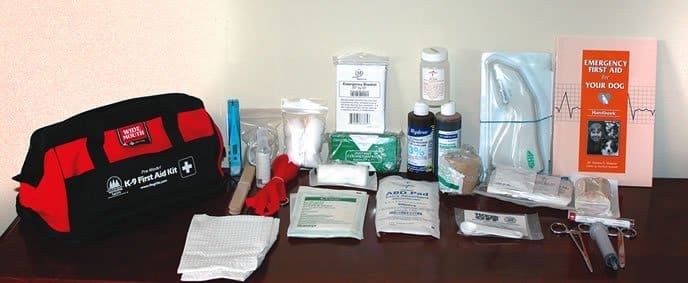
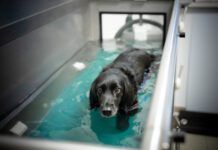
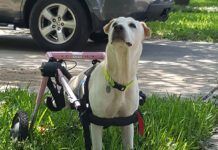


Thank you for the first and only useful review of dog first aid kits that I have encountered. It was well-written, intelligent, sensible, and highly reassuring. I was particularly pleased to see that you consulted with vets.